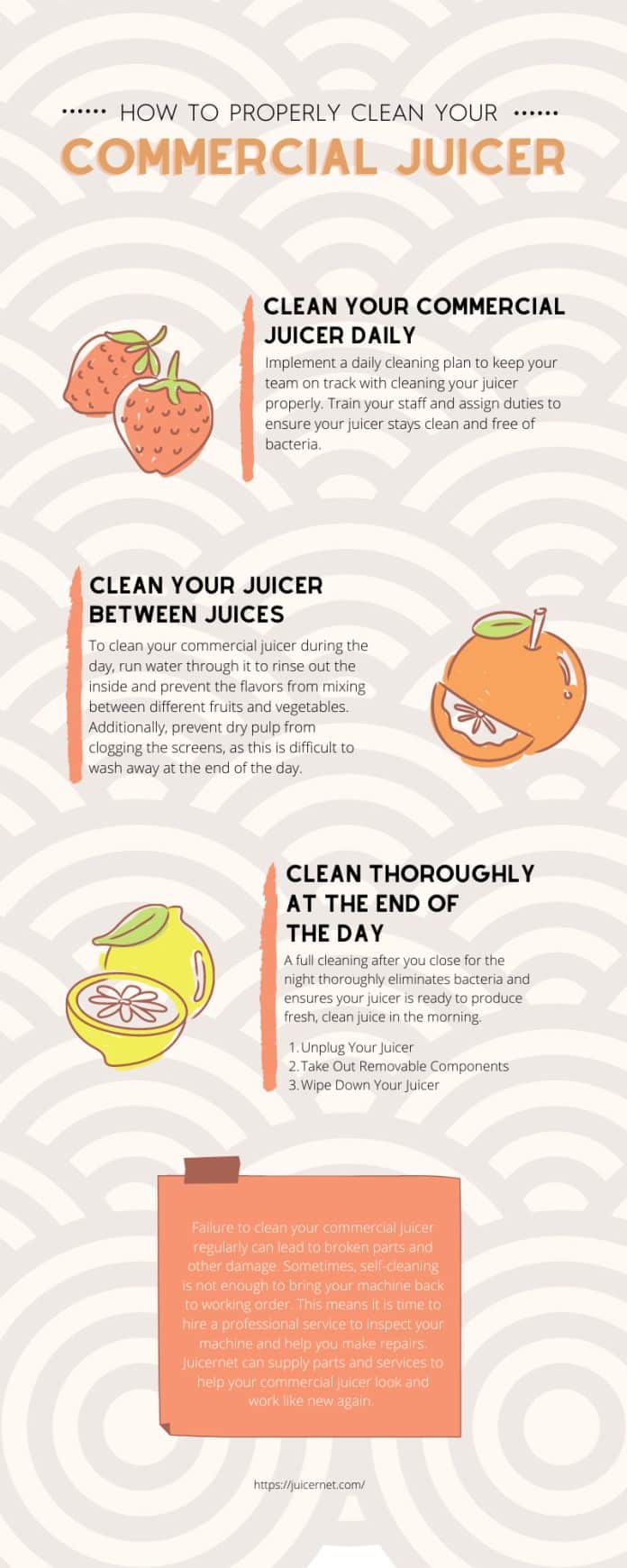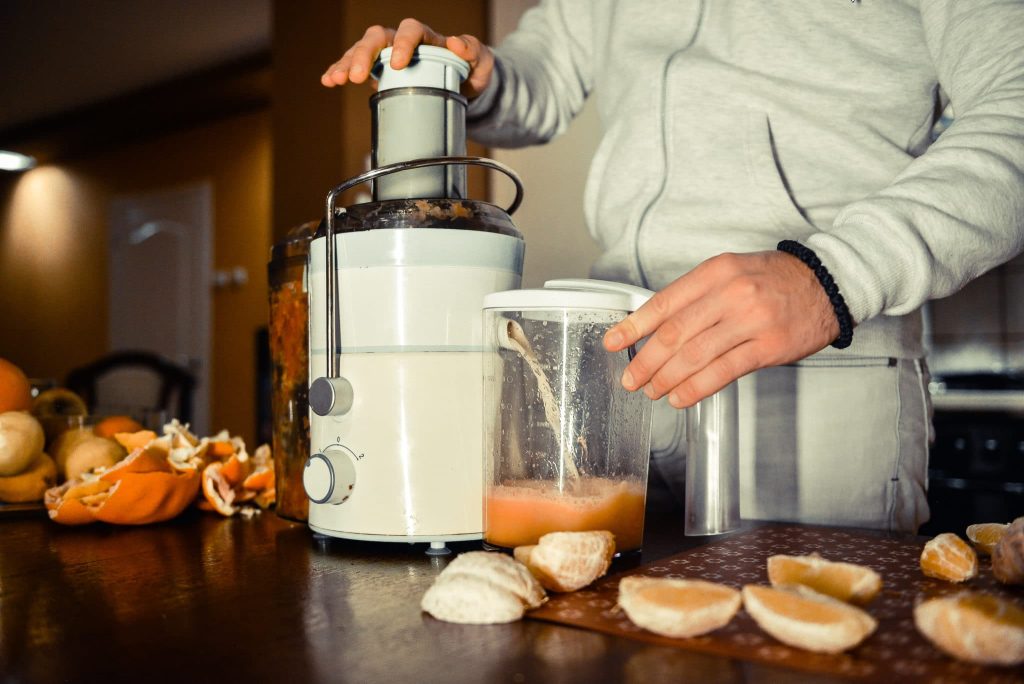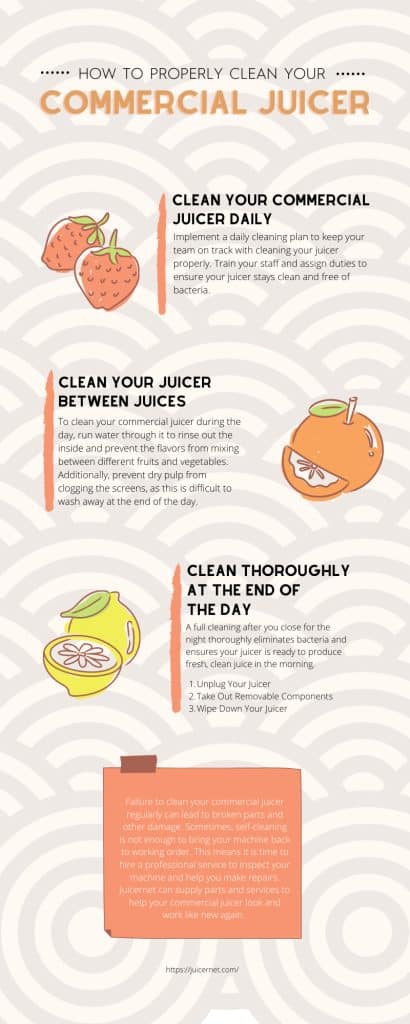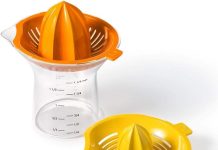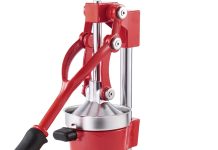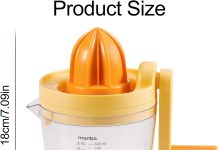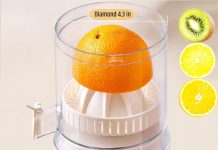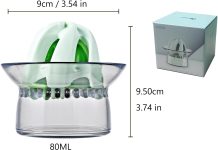Juicing has become a popular way to incorporate more fruits and vegetables into our daily routine, but the thought of cleaning the juicer can sometimes deter us from enjoying this healthy habit. That’s why we’ve prepared this article to guide you through the process of cleaning your juicer effectively, making it a breeze rather than a chore. Forget about the hassle and say hello to a sparkling clean juicer that will keep you feeling refreshed and revitalized.
This image is property of blog.squaretrade.com.
Review contents
Why is cleaning a juicer important?
Cleaning a juicer is essential for several reasons, including preventing bacteria growth, maintaining the juicer’s performance, and ensuring its longevity. By properly cleaning your juicer, you can enjoy fresh and healthy juices while avoiding potential health risks and prolonging the lifespan of your appliance.
Preventing bacteria growth
One of the primary reasons for cleaning a juicer is to prevent the growth of bacteria. When fruits and vegetables are juiced, the natural sugars in the produce can create an ideal environment for bacteria to thrive if left uncleaned. This can lead to foodborne illnesses and pose a risk to your health. Regular cleaning eliminates any residue or remnants from previous juicing sessions, ensuring that your juices remain safe to consume.
Maintaining the juicer’s performance
Another reason why cleaning a juicer is important is to maintain its performance. Over time, leftover pulp, seeds, and juice residues can accumulate in various parts of the juicer, such as the filter, blades, and feeding chute. This buildup can impede the juicer’s functionality and reduce its efficiency. By regularly cleaning all the components of your juicer, you can ensure optimal performance and continue to enjoy smooth and consistent juicing results.
Ensuring the juicer’s longevity
Cleaning your juicer regularly also plays a vital role in ensuring its longevity. Prolonged exposure to moisture and residue can lead to the development of mold, mildew, and other forms of bacterial growth. These can corrode the internal components of the juicer, leading to malfunctions and potentially rendering it unusable. By following a proper cleaning regimen, you can preserve the quality of your juicer, extend its lifespan, and get the most out of your investment.
Safety precautions before cleaning
Before starting the cleaning process, it is important to take some safety precautions to protect yourself and prevent any accidents. These precautions should be followed to ensure a safe and hassle-free cleaning experience.
Unplug the juicer
Always remember to unplug your juicer from the power source before attempting to clean it. This step is crucial as it eliminates the risk of electric shock or any other electrical mishap. Removing the power source also ensures that the juicer’s motor is not accidentally activated while cleaning, avoiding any potential injuries.
Allow the juicer to cool down
Before dismantling your juicer for cleaning, make sure to give it sufficient time to cool down. Juicers can become hot during use, and touching hot parts can lead to burns or other injuries. Allowing the juicer to cool down also helps prevent any damage that may occur due to sudden temperature changes when hot parts come into contact with water.
Refer to the user manual
Consulting the user manual that came with your juicer is a crucial step before cleaning. Each juicer model may have specific instructions or recommendations for cleaning, and it is important to follow these guidelines to ensure proper cleaning and avoid any damage to the appliance. The user manual will provide detailed instructions on disassembling, cleaning, and reassembling the juicer, as well as any specific precautions that need to be taken.
Wear protective gloves
While it may seem like a simple step, wearing protective gloves during cleaning is highly recommended. Gloves can protect your hands from any sharp blades or rough edges that may be present in the juicer’s parts. They also provide a barrier between your skin and any residual chemicals or cleaning agents you may use. By wearing gloves, you can ensure both cleanliness and safety during the cleaning process.
Cleaning immediately after juicing
Cleaning your juicer immediately after each use is essential to prevent the buildup of residue and maintain its overall cleanliness. By following these steps, you can effectively clean your juicer’s removable parts.
Disassemble the juicer
Start by carefully disassembling the juicer. Refer to your user manual for proper disassembly instructions specific to your model. Common components that need to be detached for cleaning include the pulp container, juice container, filter or strainer, cutting blade, and feeding chute. Follow the instructions in your user manual to ensure a hassle-free disassembly process.
Rinse removable parts with water
Once you have disassembled the juicer, rinse the removable parts under running water to remove any large pieces of pulp or juice residue. Use your hands or a soft brush to help loosen and remove any debris. Make sure to pay attention to hard-to-reach areas where residue may accumulate, such as corners or crevices. Thorough rinsing ensures that the majority of the organic matter is removed before further cleaning.
Use a brush to remove pulp residue
After rinsing the removable parts, use a soft brush or sponge to scrub away any remaining pulp residue. Pay close attention to the filter (or strainer) and the cutting blade, as these are the components most likely to have pulp buildup. Gently scrub in a circular motion to dislodge any stubborn residue. Be cautious not to use excessive force or abrasive materials that could damage the parts.
Clean the juicer body
While most of the cleaning focuses on the removable parts, it is also important to clean the juicer body itself. Dampen a cloth or sponge with water and mild dish soap and gently wipe down the exterior of the juicer. Pay attention to any buttons, knobs, or switches, as these areas can accumulate dirt and grime. Rinse the cloth or sponge frequently to avoid spreading dirt or residue during cleaning.
Dry all parts thoroughly
After cleaning, ensure that all the juicer parts are thoroughly dried before reassembling or storing them. Excess moisture can lead to the growth of mold or mildew, which can be harmful to both the juicer and your health. Use a clean, dry cloth or towel to remove any remaining moisture from each component. Allow them to air dry completely before proceeding with reassembly.
Deep cleaning the juicer
In addition to the regular cleaning routine, it is recommended to deep clean your juicer periodically to remove any accumulated mineral deposits, stains, or odors. Deep cleaning eliminates any stubborn residue that may have been missed during regular cleaning and keeps your juicer in top condition.
Prepare a cleaning solution
To deep clean your juicer, start by preparing a cleaning solution. Fill a sink or a basin with warm water and add a few drops of mild dish soap or kitchen cleaner. Avoid using abrasive cleaners or those containing bleach, as they can damage the juicer’s parts and potentially leave harmful residues.
Soak the parts in the solution
Once the cleaning solution is ready, immerse the removable juicer parts in the water. Ensure that all parts are fully submerged and allow them to soak for about 15-30 minutes. This soaking time helps to loosen any dried or stubborn residues, making them easier to remove during the cleaning process.
Use a soft brush or sponge
After soaking, use a soft brush or sponge to scrub the juicer parts thoroughly. Pay particular attention to areas with visible stains or buildup, such as the filter, cutting blade, and feeding chute. Gently scrub in a circular motion to dislodge any remaining residue. You can also use an old toothbrush to reach into crevices and remove any stubborn debris.
Rinse all parts with water
After scrubbing, rinse all the juicer parts under running water to remove any residual cleaning solution. Make sure to rinse each part thoroughly, ensuring that no cleaning agents are left behind. Inspect the parts visually to ensure they are completely clean and free from any residue or stains. Pay attention to hard-to-reach areas, such as corners or mesh screens, to ensure proper cleaning.
Dry and reassemble the juicer
Once all the parts have been cleaned and rinsed, carefully dry them using a clean, dry cloth or towel. Ensure that each part is completely dry before reassembling the juicer. Leaving any moisture behind can promote the growth of mold or bacteria. After drying, follow the instructions in your user manual to properly reassemble the juicer, ensuring that all the parts fit securely.
This image is property of juicernet.com.
Cleaning specific juicer parts
Different parts of the juicer require specific cleaning techniques to ensure proper maintenance and hygiene. Here are some guidelines for cleaning specific juicer components:
Cleaning the cutting blade
To clean the cutting blade, remove it from the juicer as per the user manual instructions. Carefully clean the blade with warm water and a soft brush to remove any debris or residue. Pay attention to the sharp edges of the blade and handle it with caution. Dry the blade thoroughly before reassembling it into the juicer.
Cleaning the filter or strainer
The filter or strainer is responsible for separating pulp from juice during the juicing process and can easily accumulate residue. After disassembling the juicer, remove the filter or strainer and rinse it under running water to remove larger debris. Use a soft brush, such as a toothbrush, to scrub away any remaining residue. Make sure to clean both the inside and outside of the filter/strainer. Rinse thoroughly and dry before reassembling.
Cleaning the juice container
The juice container collects the freshly extracted juice and may contain pulp remnants. Rinse the container with water and use a soft brush to remove any pulp residue. Ensure that the container is thoroughly cleaned and free from any stains or odors. Dry the container completely before storing or using it for your next juicing session.
Cleaning the pulp container
Similar to the juice container, the pulp container can accumulate residue from the fruits and vegetables. Rinse the container with water and use a brush to remove any pulp remnants. Pay attention to the corners and edges of the container, as these areas can collect more residue. Ensure that the pulp container is completely clean and dry before reinserting it into the juicer.
Cleaning the feeding chute
The feeding chute is where you insert the fruits or vegetables to be juiced. It can accumulate residue or pulp particles, which can lead to clogs or unpleasant odors. To clean the feeding chute, use a soft brush or sponge to remove any visible residue. Pay attention to the interior walls of the chute, as residue can cling to them. Rinse the chute thoroughly with water and dry it completely before reassembling the juicer.
Removing stubborn stains and odors
Despite regular cleaning, your juicer may develop stubborn stains or odors over time. Fortunately, there are several methods you can use to tackle these issues effectively:
Use a mixture of baking soda and water
A mixture of baking soda and water can help remove stubborn stains from your juicer’s components. Create a paste by mixing baking soda with a small amount of water, then apply it to the stained areas. Let the paste sit for a few minutes to allow it to penetrate the stains, then use a soft brush or sponge to scrub away the discoloration. Rinse the parts thoroughly and dry them completely.
Apply lemon juice
Lemon juice has natural cleaning properties and can be effective in removing stains and odors. Squeeze fresh lemon juice onto a cloth or sponge and use it to wipe the affected areas. For stubborn stains, let the lemon juice sit on the surface for a few minutes before scrubbing with a brush. The citric acid in lemon juice helps break down stains and leaves a fresh scent. Rinse the parts and dry them thoroughly afterward.
Soak in vinegar solution
Vinegar is a natural cleaning agent that can help remove stains, mineral deposits, and odors. Prepare a solution by mixing equal parts of white vinegar and water in a basin or sink. Submerge the stained juicer parts in this solution and let them soak for about 20-30 minutes. After soaking, use a soft brush or sponge to scrub away the stains or residue. Rinse the parts thoroughly with water and dry them completely.
Utilize specialized cleaning products
If you prefer using specialized cleaning products, there are various juicer cleaners available on the market. These cleaners are specifically formulated to remove stains, odors, and mineral deposits from juicer parts. Follow the instructions provided on the product packaging, as they may vary depending on the brand. Always rinse the parts thoroughly after using a specialized cleaner to remove any residue.
Preventive measures for odors
To prevent the development of odors in your juicer, there are a few preventive measures you can take. First, clean your juicer immediately after each use to avoid allowing residues to sit and spoil. Additionally, when storing your juicer, ensure that all parts are completely dry before reassembling or storing them. Moisture can cause unpleasant odors and even lead to mold or bacterial growth. Finally, consider periodically running some lemon or lime slices through your juicer to freshen it up naturally.
This image is property of storables.com.
Maintenance tips for a clean juicer
In addition to regular cleaning, following these maintenance tips will help keep your juicer clean and in optimal condition for a long time:
Regular cleaning schedule
Establishing a regular cleaning schedule for your juicer is essential. Depending on how often you use it, consider cleaning the juicer after each use or at least once a day if you use it frequently. Consistent cleaning prevents residue buildup and reduces the likelihood of stains or odors forming. Set aside a specific time or routine to clean your juicer to make it a habit and ensure its longevity.
Proper storage of removable parts
When not in use, store your juicer’s removable parts properly to prevent dust accumulation and maintain cleanliness. After cleaning and drying each part, reassemble them if possible and store them in a clean, dry area. Avoid placing them near sources of moisture or excessive heat to prevent mold or damage. If storing the juicer for an extended period, disassemble the parts and store them individually in a clean, dry location.
Avoiding excessive heat or direct sunlight
Exposing your juicer to excessive heat or direct sunlight can cause damage over time. The heat from sunlight can cause discoloration, warping, or deterioration of the plastic components of the juicer. Likewise, exposing the juicer to high temperatures, such as near stovetops or ovens, can lead to warping or melting of the plastic. Store the juicer in a cool, dry place away from direct sunlight to ensure its longevity.
Avoiding dishwasher use
While some juicer parts may be labeled as dishwasher safe, it is generally recommended to hand wash the removable components. Dishwashers can subject the parts to high temperatures, harsh detergents, and strong water pressure that can potentially cause damage. Additionally, some parts may be delicate or have intricate designs that are not suitable for dishwasher cleaning. Always refer to the user manual for specific instructions regarding dishwasher use.
Routine inspection for wear and tear
Regularly inspect your juicer for any signs of wear and tear that may require maintenance or replacement. Check the integrity of the blades, filters, and other components for any dullness, cracks, or breakage. If you notice any damage, contact the manufacturer or an authorized service center for repairs or replacement parts. Timely maintenance can prevent further damage and ensure the continued performance of your juicer.
Benefits of regular juicer cleaning
Regularly cleaning your juicer has numerous benefits that enhance your juicing experience and promote overall health and wellbeing:
Improved taste and flavor of juices
By regularly cleaning your juicer, you ensure that no residual flavors or odors from previous juicing sessions contaminate your fresh batches of juice. Cleaning removes any remnants of fruits and vegetables, ensuring that each juice you make has its distinct taste and essence. The absence of unwanted flavors or odors enhances the overall juicing experience, allowing you to enjoy the full freshness and flavors of your chosen ingredients.
Reduced risk of foodborne illnesses
Proper cleaning practices significantly reduce the risk of foodborne illnesses. When juicing, it is essential to remember that fruits and vegetables can harbor harmful bacteria. By cleaning your juicer thoroughly after each use, you eliminate any traces of bacteria, preventing them from multiplying and contaminating future juices. This step is particularly critical when juicing with fresh produce, as proper sanitation minimizes the potential for foodborne pathogens.
Efficient juicer performance
A clean juicer operates more efficiently, resulting in improved performance and better juice extraction. Regular cleaning ensures that the filters, blades, and other components are free from obstructions, allowing the juicer to function optimally. When the juicer is clean, it can extract juice more effectively, reducing wastage and producing higher yields. This efficiency translates into cost savings, as you can extract more juice from a given amount of produce.
Extended lifespan of the juicer
Cleaning your juicer regularly is a simple and effective way to extend its lifespan. When residue and debris accumulate in the juicer’s components, they can clog or damage the motor, blades, or other internal parts. This buildup can lead to decreased performance, increased wear and tear, and ultimately, the premature breakdown of the juicer. By maintaining a clean juicer, you minimize the risk of damage and enjoy the longevity of your appliance.
This image is property of www.thedailymeal.com.
Common mistakes to avoid while cleaning
While cleaning a juicer is a straightforward process, it is important to be aware of some common mistakes to avoid:
Using harsh chemicals
Avoid using harsh chemicals or abrasive cleaners when cleaning your juicer. Such cleaners can damage the juicer’s components, especially those made of plastic or other delicate materials. Stick to mild dish soap, vinegar solutions, or specialized juicer cleaners recommended by the manufacturer. Always refer to the user manual for approved cleaning agents and methods to avoid any potential damage.
Neglecting hard-to-reach areas
Hard-to-reach areas in your juicer, such as corners or crevices, are prone to residue buildup. Neglecting these areas during the cleaning process can result in hygiene issues or affect the juicer’s performance. Take the time to thoroughly clean all nooks and crannies using brushes or other cleaning tools suitable for the task. Paying attention to these areas ensures a comprehensive cleaning and prevents any potential problems caused by residue buildup.
Leaving parts damp or wet
After cleaning your juicer, it is crucial to dry all the parts thoroughly before reassembling or storing them. Leaving any moisture behind can promote the growth of mold or bacteria, which can cause health risks and damage the juicer’s parts. Take the extra time to ensure that each component is completely dry to maintain a hygienic and functional juicer.
Not reading the user manual
Each juicer model may have specific cleaning instructions or recommended cleaning agents. Not reading the user manual can result in using the wrong cleaning methods or inadvertently damaging the juicer’s components. Always refer to the user manual for detailed instructions on cleaning, disassembling, and reassembling your specific juicer model. Following the guidelines provided ensures proper maintenance and maximizes the lifespan of your juicer.
Skipping routine maintenance
In addition to cleaning after each use, routine maintenance is crucial to keep your juicer in prime condition. Neglecting routine maintenance tasks, such as replacing worn-out parts or lubricating the moving parts, can lead to reduced performance and potential breakdowns. Stay proactive and address any maintenance needs promptly to keep your juicer functioning at its best.
Frequently asked questions about juicer cleaning
Here are answers to some common questions regarding juicer cleaning:
Can I clean my juicer parts in the dishwasher?
While some juicer parts may be labeled as dishwasher safe, it is generally recommended to hand wash the removable components. Dishwashers can subject the parts to high temperatures, harsh detergents, and strong water pressure that can potentially cause damage. Additionally, some parts may be delicate or have intricate designs that are not suitable for dishwasher cleaning. Always refer to the user manual for specific instructions regarding dishwasher use.
How often should I clean my juicer?
To maintain optimal cleanliness and performance, it is recommended to clean your juicer after each use. This ensures that no residue or bacteria remain in the juicer’s parts, preventing the development of stains, odors, or potential health risks. Additionally, periodic deep cleaning should be performed to remove any stuck-on residue or mineral deposits. The frequency of deep cleaning depends on the juicer’s usage and the manufacturer’s instructions.
What should I do if my juicer smells bad?
If your juicer has developed a bad odor, it is essential to address it promptly to prevent the spread of bacteria or mold. Start by thoroughly cleaning the juicer, paying close attention to all removable parts. Use a mixture of lemon juice, water, and baking soda as a cleaning solution to help neutralize odors. Additionally, consider running some lemon or lime slices through your juicer to naturally freshen it up. If the odor persists, contact the manufacturer or consult your user manual for further guidance.
Can I use bleach to clean my juicer?
It is generally not recommended to use bleach to clean your juicer. Bleach can be too harsh for many juicer parts, especially those made of plastic, rubber, or other delicate materials. Bleach may damage the components, leave unwanted residues, and pose health risks if not rinsed thoroughly. Stick to mild dish soap, vinegar solutions, or specialized juicer cleaners recommended by the manufacturer. Always refer to the user manual for approved cleaning agents and methods.
Is it safe to clean the juicer while it is plugged in?
No, it is not safe to clean the juicer while it is plugged in. Always remember to unplug your juicer from the power source before attempting to clean it. This step is crucial to eliminate the risk of electric shock or any other electrical mishap. Additionally, cleaning the juicer while it is plugged in can lead to accidental activation of the motor, causing potential injuries. Prioritize safety by disconnecting the juicer from its power source before cleaning.
This image is property of homeexplained.com.

